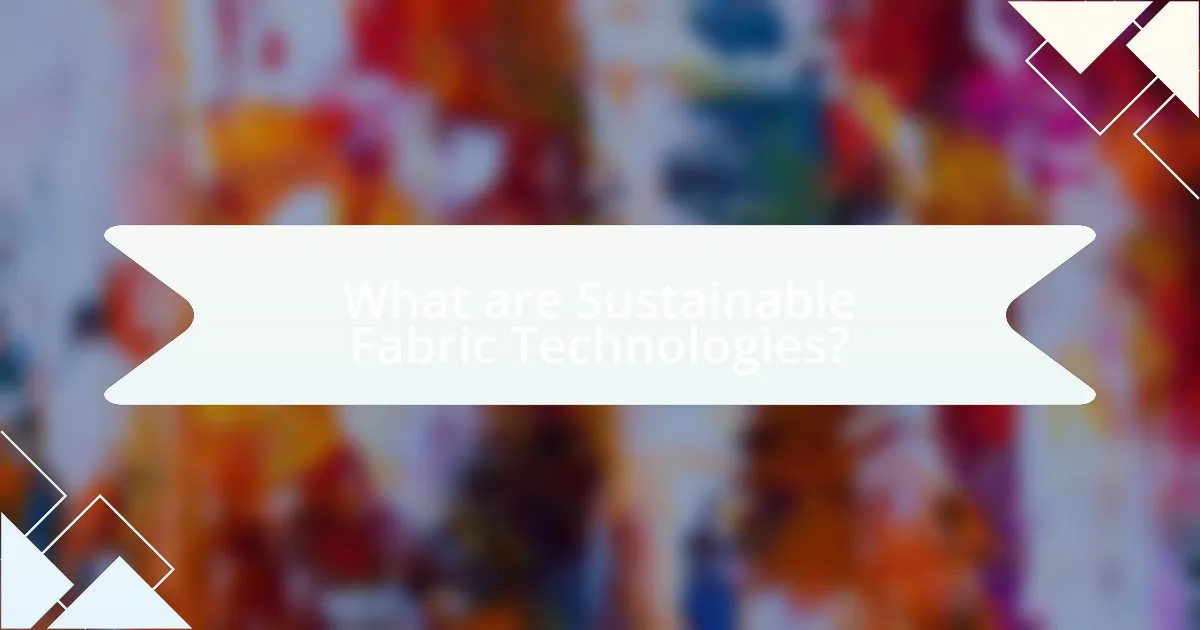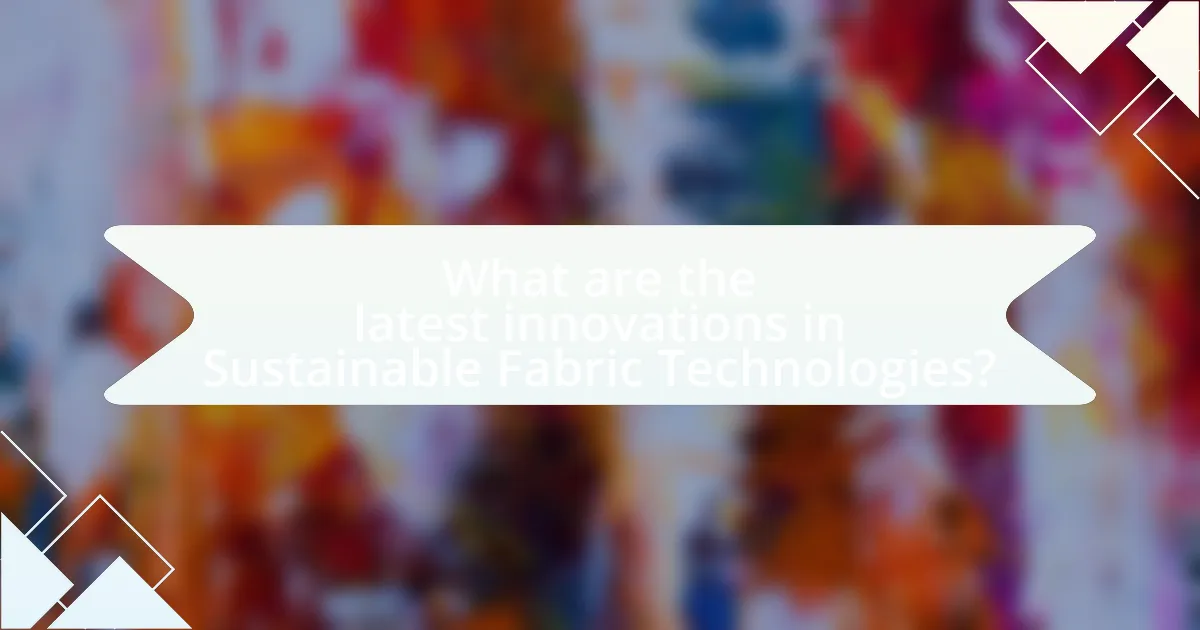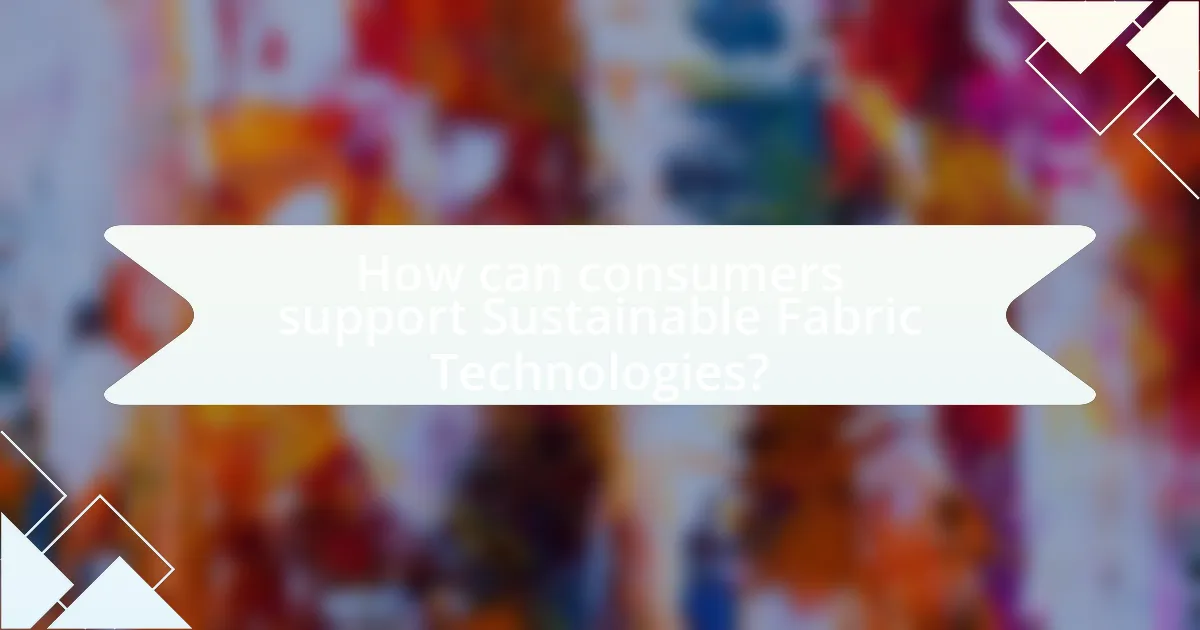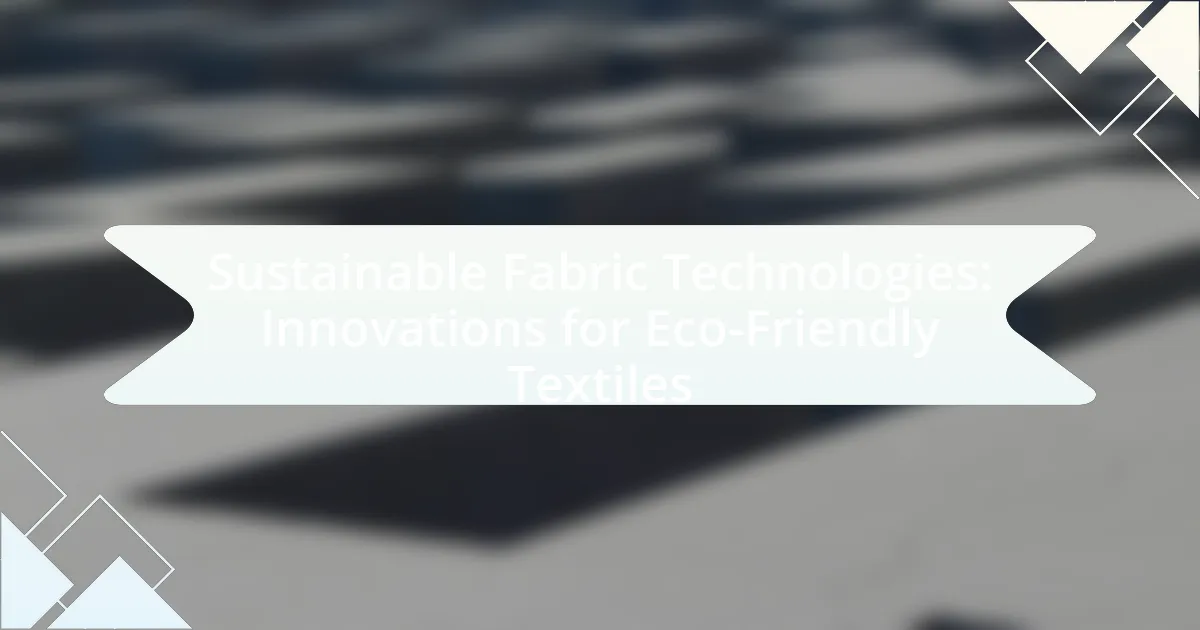Sustainable fabric technologies encompass innovative methods and materials aimed at reducing the environmental impact of textile production. This article explores the differences between sustainable and traditional textiles, highlighting the use of organic fibers, recycled materials, and eco-friendly dyes. It discusses the benefits of materials such as organic cotton, hemp, and Tencel, as well as the role of bio-based fabrics and recycled materials in promoting sustainability. Additionally, the article addresses the importance of these technologies in mitigating environmental issues, the latest innovations in the field, and practical tips for consumers to support sustainable practices in their daily lives.

What are Sustainable Fabric Technologies?
Sustainable fabric technologies are innovative methods and materials designed to minimize environmental impact in textile production. These technologies include the use of organic fibers, recycled materials, and eco-friendly dyes, which significantly reduce water consumption, chemical usage, and waste generation. For instance, the Global Organic Textile Standard (GOTS) certifies organic textiles that meet strict environmental and social criteria, ensuring sustainable practices throughout the supply chain. Additionally, advancements in bio-based fabrics, such as those made from algae or recycled plastics, further demonstrate the potential for sustainable alternatives in the fashion industry.
How do Sustainable Fabric Technologies differ from traditional textiles?
Sustainable fabric technologies differ from traditional textiles primarily in their environmental impact and resource utilization. Traditional textiles often rely on non-renewable resources, such as petroleum-based fibers, and involve chemical processes that can harm ecosystems. In contrast, sustainable fabrics utilize renewable resources, such as organic cotton or recycled materials, and employ eco-friendly production methods that minimize water usage and chemical pollution. For instance, according to the Textile Exchange’s 2021 report, organic cotton farming uses 91% less water than conventional cotton farming, highlighting the significant resource savings associated with sustainable practices.
What materials are commonly used in Sustainable Fabric Technologies?
Sustainable Fabric Technologies commonly utilize materials such as organic cotton, hemp, Tencel (lyocell), recycled polyester, and bamboo. Organic cotton is grown without synthetic pesticides or fertilizers, reducing environmental impact. Hemp is a fast-growing plant that requires minimal water and no pesticides, making it highly sustainable. Tencel, derived from sustainably sourced wood pulp, is produced in a closed-loop process that recycles water and solvents. Recycled polyester is made from post-consumer plastic bottles, diverting waste from landfills and reducing reliance on virgin materials. Bamboo grows rapidly and can be cultivated without harmful chemicals, contributing to its eco-friendly profile. These materials collectively support the goal of reducing the ecological footprint of textile production.
How do these materials contribute to sustainability?
Sustainable fabric technologies contribute to sustainability by utilizing renewable resources and reducing environmental impact during production and disposal. For instance, materials like organic cotton and Tencel are derived from sustainable farming practices and closed-loop processes, minimizing water usage and chemical pollution. Additionally, recycled polyester, made from post-consumer plastic bottles, diverts waste from landfills and reduces reliance on virgin petroleum-based fibers. These innovations not only lower carbon footprints but also promote circular economy principles, as they can be recycled or biodegraded, further enhancing their sustainability credentials.
Why is the development of Sustainable Fabric Technologies important?
The development of Sustainable Fabric Technologies is important because it addresses the environmental impact of the textile industry, which is responsible for significant pollution and resource depletion. Sustainable fabrics reduce reliance on non-renewable resources, minimize waste, and lower carbon emissions. For instance, the production of conventional cotton requires extensive water usage and pesticides, while sustainable alternatives like organic cotton or recycled polyester use fewer resources and have a lower ecological footprint. According to the Ellen MacArthur Foundation, transitioning to a circular economy in textiles could reduce greenhouse gas emissions by 44% by 2030. This highlights the critical role that sustainable fabric technologies play in promoting environmental sustainability and combating climate change.
What environmental issues do these technologies address?
Sustainable fabric technologies address several critical environmental issues, including resource depletion, pollution, and waste management. These technologies aim to reduce the consumption of water and energy during production processes, thereby conserving natural resources. For instance, innovations such as waterless dyeing techniques significantly minimize water usage, addressing the global water scarcity issue. Additionally, sustainable fabrics often utilize biodegradable materials, which help reduce landfill waste and pollution associated with synthetic textiles. Research indicates that the fashion industry is responsible for 10% of global carbon emissions, and adopting eco-friendly textiles can mitigate this impact by lowering greenhouse gas emissions during production and disposal.
How do Sustainable Fabric Technologies impact the fashion industry?
Sustainable fabric technologies significantly impact the fashion industry by reducing environmental harm and promoting ethical production practices. These technologies, such as organic cotton, recycled polyester, and innovative materials like Tencel, minimize water usage, decrease carbon emissions, and reduce waste. For instance, the use of recycled polyester can save up to 60% of the energy required to produce virgin polyester, according to the Textile Recycling Association. Additionally, sustainable fabrics often involve ethical labor practices, which enhance brand reputation and consumer trust. As a result, the adoption of sustainable fabric technologies is reshaping industry standards and consumer expectations, driving a shift towards more responsible fashion practices.

What are the latest innovations in Sustainable Fabric Technologies?
The latest innovations in sustainable fabric technologies include the development of bio-based textiles, such as those made from organic cotton, hemp, and recycled materials, which significantly reduce environmental impact. For instance, companies like Adidas have introduced shoes made from ocean plastic, demonstrating a commitment to recycling and sustainability. Additionally, advancements in dyeing processes, such as waterless dyeing technologies, minimize water usage and chemical waste, further enhancing sustainability in fabric production. Research from the Ellen MacArthur Foundation highlights that transitioning to circular fashion, which emphasizes recycling and reusing materials, can reduce textile waste by up to 80%. These innovations collectively contribute to a more sustainable textile industry.
How are bio-based fabrics changing the textile landscape?
Bio-based fabrics are transforming the textile landscape by providing sustainable alternatives to conventional materials, significantly reducing environmental impact. These fabrics, derived from renewable resources such as plants, algae, and even waste materials, contribute to lower carbon emissions and decreased reliance on fossil fuels. For instance, the production of bio-based polyester can reduce greenhouse gas emissions by up to 70% compared to traditional petroleum-based polyester. Additionally, bio-based fabrics often require less water and energy during production, further enhancing their sustainability profile. This shift towards bio-based materials is not only fostering innovation in textile manufacturing but also encouraging consumers to prioritize eco-friendly options, thereby reshaping market demand and industry practices.
What are the benefits of using bio-based fabrics?
Bio-based fabrics offer several benefits, including reduced environmental impact, biodegradability, and the use of renewable resources. These fabrics are typically made from natural materials such as cotton, hemp, or bamboo, which require less energy and water to produce compared to synthetic fabrics derived from petroleum. Additionally, bio-based fabrics decompose more easily in the environment, minimizing landfill waste and pollution. According to a study published in the Journal of Cleaner Production, the production of bio-based textiles can lead to a 50% reduction in greenhouse gas emissions compared to conventional textiles, highlighting their potential for promoting sustainability in the fashion industry.
Which companies are leading in bio-based fabric innovations?
Leading companies in bio-based fabric innovations include DuPont, which has developed bio-based fibers like Sorona, and Patagonia, known for its use of recycled and bio-based materials in its products. Another key player is Bolt Threads, recognized for its Mylo fabric made from mycelium. These companies are at the forefront of integrating sustainable practices into textile production, contributing to a significant reduction in environmental impact. For instance, DuPont’s Sorona fiber is made from 37% renewable plant-based ingredients, showcasing a commitment to sustainability in fabric technology.
What role do recycled materials play in Sustainable Fabric Technologies?
Recycled materials are crucial in Sustainable Fabric Technologies as they significantly reduce environmental impact by minimizing waste and resource consumption. By repurposing materials such as plastic bottles and textile scraps, these technologies lower the demand for virgin resources, thereby conserving energy and reducing greenhouse gas emissions. For instance, using recycled polyester can save up to 75% of the energy required to produce new polyester from petroleum. This practice not only diverts waste from landfills but also promotes a circular economy, where materials are continuously reused, enhancing sustainability in the textile industry.
How is recycling integrated into fabric production?
Recycling is integrated into fabric production through the use of post-consumer and post-industrial textile waste to create new fibers and materials. This process involves collecting discarded textiles, sorting them, and then mechanically or chemically breaking them down to produce recycled fibers, which can be spun into new yarns. For instance, brands like Patagonia and H&M utilize recycled polyester made from plastic bottles, demonstrating a practical application of recycling in fabric production. According to the Textile Recycling Association, recycling textiles can save up to 20,000 liters of water per ton of fabric produced, highlighting the environmental benefits of this integration.
What are the challenges of using recycled materials in textiles?
The challenges of using recycled materials in textiles include issues related to quality, availability, and processing. Recycled materials often have inconsistent quality due to variations in the source materials, which can affect the durability and performance of the final textile products. Additionally, the supply of recycled materials can be limited, making it difficult for manufacturers to scale production. Processing recycled materials can also require specialized technology and methods, which may not be widely available or cost-effective. According to a study published in the Journal of Cleaner Production, the recycling process can lead to a loss of material properties, further complicating the use of recycled textiles in high-performance applications.

How can consumers support Sustainable Fabric Technologies?
Consumers can support Sustainable Fabric Technologies by choosing products made from eco-friendly materials and brands that prioritize sustainable practices. By purchasing textiles made from organic cotton, recycled polyester, or other sustainable fibers, consumers directly contribute to reducing environmental impact. Additionally, supporting brands that are transparent about their supply chains and manufacturing processes encourages more companies to adopt sustainable practices. Research indicates that the global market for sustainable textiles is projected to reach $8.25 billion by 2027, highlighting the growing consumer demand for eco-friendly options.
What should consumers look for when choosing eco-friendly textiles?
Consumers should look for certifications, materials, and production processes when choosing eco-friendly textiles. Certifications such as Global Organic Textile Standard (GOTS) and OEKO-TEX ensure that textiles meet environmental and social criteria. Additionally, consumers should prioritize natural fibers like organic cotton, hemp, and linen, which have a lower environmental impact compared to synthetic fibers. Furthermore, the production processes should minimize water usage, chemical treatments, and carbon emissions, as evidenced by practices in sustainable fashion brands that focus on reducing their ecological footprint.
How can consumers identify truly sustainable brands?
Consumers can identify truly sustainable brands by examining their transparency, certifications, and supply chain practices. Brands that openly share information about their sourcing, production processes, and environmental impact demonstrate a commitment to sustainability. Certifications such as Global Organic Textile Standard (GOTS) or OEKO-TEX indicate adherence to specific environmental and social criteria. Additionally, brands that prioritize ethical labor practices and use eco-friendly materials, such as organic cotton or recycled fibers, further validate their sustainability claims. Research shows that consumers increasingly prefer brands with clear sustainability practices, as evidenced by a 2021 Nielsen report indicating that 73% of global consumers are willing to change their consumption habits to reduce environmental impact.
What certifications indicate sustainable practices in textiles?
Certifications that indicate sustainable practices in textiles include Global Organic Textile Standard (GOTS), OEKO-TEX Standard 100, and the Better Cotton Initiative (BCI). GOTS certifies organic fibers and ensures environmentally and socially responsible manufacturing processes, covering the entire textile supply chain. OEKO-TEX Standard 100 tests textiles for harmful substances, ensuring safety for human health and the environment. BCI promotes sustainable cotton production practices, aiming to reduce the environmental impact of cotton farming. These certifications provide consumers with assurance that the textiles they purchase adhere to recognized sustainability standards.
What are some practical tips for incorporating sustainable fabrics into daily life?
Incorporating sustainable fabrics into daily life can be achieved by choosing clothing made from organic cotton, hemp, or recycled materials. These fabrics reduce environmental impact due to their lower resource consumption and waste generation during production. For instance, organic cotton uses 91% less water than conventional cotton, making it a more sustainable choice. Additionally, consumers can support brands that prioritize ethical manufacturing practices and transparency in their supply chains. By opting for second-hand clothing or participating in clothing swaps, individuals can extend the lifecycle of garments, further minimizing waste. Lastly, maintaining and repairing clothing instead of discarding it contributes to sustainability by reducing the demand for new textiles.
How can consumers extend the life of their sustainable textiles?
Consumers can extend the life of their sustainable textiles by following proper care and maintenance practices. Washing textiles in cold water reduces energy consumption and minimizes wear, while air drying instead of using a dryer prevents damage from high heat. Additionally, using gentle detergents that are free from harsh chemicals helps maintain the integrity of the fabric. Regularly repairing minor damages, such as stitching up small tears, can also prolong the lifespan of these textiles. According to the Ellen MacArthur Foundation, extending the life of clothing by just nine months can reduce carbon, water, and waste footprints by 20-30%.
What are the best practices for caring for eco-friendly fabrics?
The best practices for caring for eco-friendly fabrics include washing in cold water, using mild detergents, air drying, and avoiding bleach. Washing in cold water conserves energy and reduces the risk of shrinking or damaging the fabric. Mild detergents are less harmful to both the fabric and the environment, as they contain fewer harsh chemicals. Air drying minimizes energy consumption and helps maintain the integrity of the fabric. Avoiding bleach prevents degradation of the fibers, which is particularly important for natural materials like organic cotton or hemp. These practices not only extend the life of eco-friendly fabrics but also align with sustainable living principles.

Leave a Reply